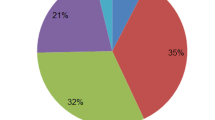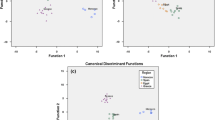Abstract
The objective of the present work was to investigate whether the combination of sugars (fructose, glucose, sucrose, and maltose) or sugar mathematical transformations (fructose plus glucose content and fructose-to-glucose ratio) and electro-chemical parameters [liquid resistivity (LR), total dissolved solids (TDS), and salinity] of Greek nectar honeys, namely, thyme and citrus, could enhance the existence of some reliable markers of honey geographical and botanical origin identification using multivariate statistics. Sugars were determined using high-performance liquid chromatography coupled to a refractive index detector, whereas electro-chemical parameters using a lab-scaled conductivity meter. Results showed that both sugar and electro-chemical parameters varied significantly (p < 0.05) according to geographical and botanical origin of nectar honeys. Application of multivariate statistics such as exploratory factor analysis, multivariate analysis of variance, and linear discriminant analysis showed that sucrose, maltose, sum of fructose and glucose contents, LR, TDS, and salinity could be used as indices of Greek thyme honey geographical origin, whereas fructose and maltose contents along with the ratio of fructose to glucose, as markers of nectar honey botanical origin, as reflected by the satisfactory prediction rates obtained.


Similar content being viewed by others
References
Crane E (1991) Honey from honeybees and other insects. Ethol Ecol Evol 3(sup1):100–105
Ouchemoukh S, Louaileche H, Schweitzer P (2007) Physicochemical characterization and pollen spectrum of some Algerian honeys. Food Control 18(1):52–58
Pita-Calvo C, Vazquez M (2017) Differences between honeydew and blossom honeys: a review. Trends Food Sci Technol 59:79–87
Boffo EF, Tavares LA, Tobias ATB, Ferreira MMC, Ferreira AG (2012) Identification of components of Brazilian honey by 1H NMR and classification of its botanical origin by chemometric methods. LWT Food Sci Technol 49:55–63
Da Costa Leite JM, Trugo LC, Costa LSM, Quinteiro LMC, Barth OM, Dutrad VML, De Maria CAB (2000) Determination of oligosaccharides in Brazilian honeys of different botanical origin. Food Chem 70:93–98
Cotte JF, Casabianca H, Chardon S, Lheritier J, Grenier-Loustalot MF (2004) Chromatographic analysis of sugars applied to the characterisation of monofloral honey. Anal Bioanal Chem 380:698–705
Nozal MJ, Bernal JL, Toribio L, Alamo M, Diego JC (2005) The use of carbohydrate profiles and chemometrics in the characterization of natural honeys of identical geographical origin. J Agric Food Chem 53:3095–3099
Kędzierska-Matysek M, Florek M, Wolanciuk A, Barłowska J, Litwińczuk Z (2018) Concentration of minerals in nectar honeys from direct sale and retail in Poland. Biol Trace Elem Res. https://doi.org/10.1007/s12011-018-1315-0 (in press)
Karabagias IK, Karabournioti S (2018) Discrimination of clover and citrus honeys from Egypt according to floral type using easily assessable physicochemical parameters and discriminant analysis: an external validation of the chemometric approach. Foods 7(5):70
Venir E, Spaziani M, Maltini E (2010) Crystalization in “Tarassaco” Italian honey studied by DSC. Food Chem 122:410–415
Escuredo O, Míguez M, Fernández-González M, Carmen Seijo M (2013) Nutritional value and antioxidant activity of honeys produced in a European Atlantic area. Food Chem 138:851–856
Escuredo O, Dobre I, Fernández-González M, Carmen Seijo M (2014) Contribution of botanical origin and sugar composition of honeys on the crystallization phenomenon. Food Chem 149:84–90
Karabagias IK, Vlasiou M, Kontakos S, Drouza C, Kontominas MG, Keramidas AD (2018) Geographical discrimination of pine and fir honeys using multivariate analyses of major and minor honey components identified by 1H NMR and HPLC along with physicochemical data. Eur Food Res Technol 244(7):1249–1250
Özbalci B, Boyaci IH, Topcu A, Kadılar C, Tamer U (2013) Rapid analysis of sugars in honey by processing Raman spectrum using chemometric methods and artificial neural networks. Food Chem 136:1444–1452
Spilioti E, Jaakkola M, Tolonen T, Lipponen M, Virtanen V, Chinou I, Kassi E, Karabournioti S, Moutsatsou P (2014) Phenolic acid composition, antiatherogenic and anticancer potential of honeys derived from various regions in Greece. PLOS ONE 9(4):e94860
Zielinski AAF, Haminium CWI, Nunes CA, Schnitzler E, van Ruth SM, Granato D (2014) Chemical composition, sensory properties, provenance, and bioactivity of fruit juices as assessed by chemometrics: a critical review and guideline. Compr Rev Food Sci F 13:300–316
(2002) Council directive 2001/110/EC relating to honey. Off J Eur Commun 10:47–52
Nousias P, Karabagias IK, Kontakos S, Riganakos KA (2017) Characterization and differentiation of Greek commercial thyme honeys according to geographical origin based on quality and some bioactivity parameters using chemometrics. J Food Process Preserv 41(4):e13061
Harmonized Methods of the International Honey Commision (IHC) (1997) IHC responsible for the methods: Stefan Bogdanov. Swiss Bee Research Centre FAM, Liebefeld, CH-C3003 Bern, Switzerland
Wei J, Ding M-Y (2000) Analysis of carbohydrates in drinks by high-performance liquid chromatography with a dynamically modified amino column and evaporative light scattering detection. J Chromatogr A 904:113–117
Lowrie W (2007) Fundamentals of geophysics. Cambridge University Press, Cambridge, UK, p 254
Norris M, Lecavalier L (2010) Evaluating the use of exploratory factor analysis in developmental disability psychological research. J Autism Dev Disord 40(1):8–20
Fabrigar LR, Wegener DT, MacCallum RC, Strahan EJ (1999) Evaluating the use of exploratory factor analysis in psychological research. Psychol Methods 4(3):229–272
Finch JF, West SG (1997) The investigation of personality structure: statistical models. J Res Pers 31(4):439–485
Ruscio J, Roche B (2012) Determining the number of factors to retain in an exploratory factor analysis using comparison data of a known factorial structure. Psychol Assess 24(2):282–292
Mateo R, Bosch-Reig F (1997) Sugar profiles of Spanish unifloral honeys. Food Chem 60(1):33–41
Al ML, Daniel D, Moise A, Bobis O, Laslo L, Bogdanov S (2009) Physicochemical and bioactive properties of different floral origin honeys from Romania. Food Chem 112(4):863–867
Gleiter RA, Horn H, Isengard HD (2006) Influence of type and state of crystallisation on the water activity of honey. Food Chem 96(3):441–445
De la Fuente E, Ruiz-Matute AI, Valencia-Barrera RM, Sanz J, Castro M (2011) Carbohydrate composition of Spanish unifloral honeys. Food Chem 129:1483–1489
Khalil MI, Moniruzzaman M, Boukraâ L, Benhanifia M, Islam MA, Islam MN, Sulaiman SA, Gan SH (2012) Physicochemical and antioxidant properties of Algerian honey. Molecules 17:11199–11215
Pentoś K, Łuczycka D (2018) Dielectric properties of honey: the potential usability for quality assessment. Eur Food Res Technol 244:873–880
Karabagias IK, Louppis A, Kontakos S, Drouza Ch, Papastephanou C (2018) Characterization and botanical differentiation of monofloral and multifloral honeys produced in Cyprus, Greece and Egypt using physicochemical parameter analysis and mineral content, in conjunction with supervised statistical techniques. J Anal Methods Chem 2018:7698251
Acknowledgements
The author is grateful to Attiki Bee Culturing Co.-Alex. Pittas S.A. for the donation of honey samples and to Dr. Sofia Karabournioti for her excellent assistance in the melissopalynological analysis. Prof. M.G. Kontominas is also acknowledged for the access he provided to the laboratory of Food Chemistry at Chemistry Department of University of Ioannina during my Post Doctoral studies.
Funding
This research did not receive any specific grant from funding agencies in the public, commercial, or not-for-profit sectors.
Author information
Authors and Affiliations
Corresponding author
Ethics declarations
Compliance with ethics requirements
This article does not contain any studies with human or animal subjects.
Conflict of interest
The author declares no conflict of interest.
Additional information
Publisher’s Note
Springer Nature remains neutral with regard to jurisdictional claims in published maps and institutional affiliations.
Electronic supplementary material
Below is the link to the electronic supplementary material.
Rights and permissions
About this article
Cite this article
Karabagias, I.K. Seeking of reliable markers related to Greek nectar honey geographical and botanical origin identification based on sugar profile by HPLC-RI and electro-chemical parameters using multivariate statistics. Eur Food Res Technol 245, 805–816 (2019). https://doi.org/10.1007/s00217-018-3216-z
Received:
Revised:
Accepted:
Published:
Issue Date:
DOI: https://doi.org/10.1007/s00217-018-3216-z




